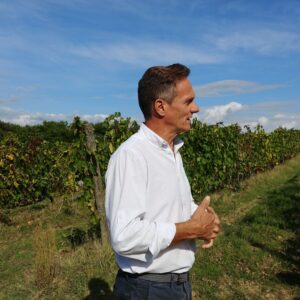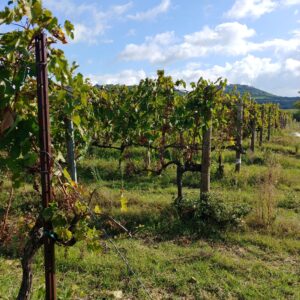It is part of human nature to want to compare our lives to those around us. Whether it is in regards to marriage and kids, financial success or achievements, there are times when all of us feel inadequate. In our twenties we panic that the superficial markers (the stuff we feel the need to accumulate for a fulfilled and successful life) will not happen; in our thirties we feel under the gun to make those things happen (right now!); in our forties we regret the things we haven’t yet achieved. Through it all, we spend too much time being unhappy about what boxes we didn’t check off so that we could be happy.

During my recent time in Montalcino, Tuscany, I visited several Brunello di Montalcino producers that discussed not only the current vintage but also changes that they are making for their estates; one such visit that stood out was with Leonardo Bellaccini, winemaker of Agricola San Felice and Campogiovanni.
San Felice is a historic Chianti Classico estate whose surrounding village can be traced back to the 8th century. Their Brunello property, Campogiovanni, located in the southwestern part of Montalcino, has been under an extensive overview of analyzing and sometimes re-planting of vineyards. As I walked through the vineyards with Leonardo, he thoroughly explained in his candid answers that there is no one sweeping statement that can truly express their philosophy with the land.
All of the different sections of the vineyards at Campogiovanni looked different; how the vines were spaced, how they were trellised, how densely they were planted. At one moment Leonardo was pointing to vines that were over 50 years old and the next he was motioning at those that were planted in 1986, or in 2008, or even others that were just recently planted.

He was talking about how some of the vineyards did better with a higher density planting, 9,000 vines per 2.5 acres (1 hectare) as opposed to their already well-established 3,000, as more vines cause competition for nutrients and so the energy goes more into the grapes than the foliage. But high- density planting was not the ideal answer for every section, depending on the fertility of the soil, just like another change Leonardo implemented by using a different trellising system that can control the yield of the grapes.
Leonardo emphasized that it wasn’t about trying to get the smallest yield every year as some years the grapes were concentrated enough and to push those grapes’ ripeness even further would only make over-extracted, over-alcoholic wines. He noted that back in the 70’s and 80’s, some Chianti producers went for high yields making simpler wines which inspired the Brunello producers to go for extremely low yields, but now they are finding more of a balance, especially with the average weather getting warmer. They realized that when the grapes are too concentrated and over-ripe, the beauty and elegance of the Sangiovese grape is masked.
It was fascinating to hear Leonardo talk about the unique qualities of each place while he showed different portions of the vineyards, each section of vines, how they needed to be treated differently and in various vintages how their performance would be different from the year before; sometimes a section of grapes would be complex and rich enough to become part of the Brunello di Montalcino final blend, while at other times it would be declassified for Rosso di Montalcino, because it was fresher and generous in its youth. The idea was that each section needed to be treated in its own way instead of forcing an overall system for all the vineyards to obtain the best of each vine’s potential.
Anytime I hear someone apologizing for her life, apologizing for simply making unconventional choices or sometimes not being given the choice to live a conventional life, I think how detrimental it would be for the world if all of us lived the same life. It is great that some people have children and others do not, the same with marriage, as well as the same with having a career of prominence; all of those things take a significant amount of energy and hence doing everything is not possible, so the world works better when we all make different choices as we can be part of lifting up our society in varying ways.
Just like there is no one way to plant, manage or sustain a grape vine–even in the same vineyard with the same grape–there is no one ultimate destiny for the vine that determines its worth. Many wine drinkers get great enjoyment out of Rosso di Montalcino like its bigger brother, Brunello. No matter where you are in life– such as if you are meant to be a Rosso for most of it– then you can warm your heart with the idea that you are giving wine drinkers a chance to get a hint of Brunello for a price that is attainable for those even on a budget. And, who knows, perhaps there will be that one year where surprisingly, you will be picked to be a Brunello despite not having had a conventional road, yet somehow it happened. In the end it doesn’t matter, because you are always right where you ought to be.
Everyday Drinking Wine (less than $15)
2017 San Felice, Chianti Classico DOCG, Tuscany, Italy ($13): 80% Sangiovese, 10% Colorino, and 10% Pugnitello. The historic Chianti Classico property San Felice, owner of Campogiovanni, makes a Chianti that is ideal for everyday drinking and never disappoints. Good fleshiness on the body with fresh acidity, bright red cherries and a hint of earth on the finish.
Special Occasion Wine (from $15 to $50)
2016 Campogiovanni (San Felice), Rosso di Montalcino DOC, Tuscany, Italy ($20): 100% Sangiovese. A pretty, red raspberry flavored, smooth textured Rosso with spice and smoke that gave it delightful complexity on the flavorful finish.
2013 Campogiovanni (San Felice), Brunello di Montalcino DOCG, Tuscany, Italy ($48): 100% Sangiovese. I really love the 2013 Campogiovanni as it combines beautiful aromatics and freshness with rich fruit flavor, complexity and silky tannins. Dark chocolate with ripe dark berries that had hints of smoldering earth and sweet tobacco leaf.

Fantasy Wine (over $50)
2008 Campogiovanni (San Felice), Brunello di Montalcino Riserva DOCG ’Il Quercione’, Tuscany, Italy ($118): 100% Sangiovese. When I visited Leonardo Bellaccini at Campogiovanni he was kind enough to open a 2008 Brunello di Montalcino Riserva ‘Il Quercione’ that came from a vineyard with a sandy topsoil and clay underneath and “the wine shows the elegance of the sandy soil and the volume that comes from the clay” according to Leonardo. A whiff of lavender with cherry blossoms on the nose invited me in with juicy cassis fruit on the body that had layers of fresh leather, minerality and dried sage leading to a vibrant, dense finish.
The 2008 Brunello di Montalcino Riserva was the only wine listed above that was tasted during my visit with Leonardo Bellaccini at Campogiovanni. The other wines I have tasted at other times here in New York City and chose them because they fit the price point as well as being favorites of mine in those categories.












